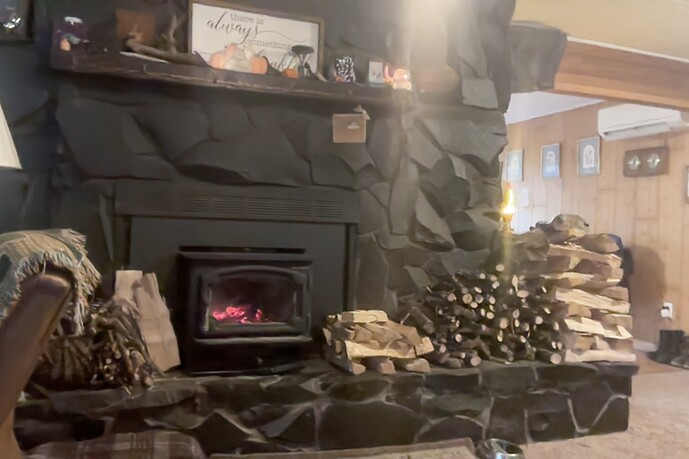Hello AlexH
Have you working used already oxidization catalytic converters??
In USA vehicles all have had these since the 1980’s.
Then many 90’s and later woodstoves have had these.
Some small engines like chainsaws, and motorcycles have had these.
Some manufacturers treating these as just an add-on exhaust-problem, go-bye-bye, garbage truck.
Actually working catalytic converters are finicky and need a lot of controlled hands holding to function and live.
They only start working when up to thier high internal operating temperstures. HC combustion gasses flowed through them too early, not hot enough yet, will soot them up cover coating the active agents. Then inactive. Soots can build up clogging flow throughs.
Wood stove usually have a cold starting fire, manual bypass passages.
Vehicles in the US from the late 70’s and and it has become the driven need for the cats that bias-skews the whole of vehicle conditions.
From the needs for non-leaded fuels. To especially getting the exhausts flows up to hot ASAP, and not too carburetor/intake cold fuel over-rich. And not too hot working engine enleaned out, too lean. Some fuel has to be sacrificed to give the cat enough fuel for the internal oxidization heat, to be able to temperature boost itself. Many later cats having added pumped in air to boost the combustion heat.
With first a 5yr/50,000 mile guarantee/warranty responsibly on the original vehicle manufacturer, they learned they had to go with electronic fuel injections to get the better finite fuel controls. To keep their under-warrantee “free” cat replacement costs down. Later; that was US EPA extended out to an 8yrs/80,000 mile manufacturers obligation. Then the vehicle manufacturers had to add more sensors, and programed to not just scream out Cat-Danger but actively pull the power and gears away from the operators. And then the manufactures were screaming at the engine oil companies to get the engine-wear saving metallics and calciums out of the oils. Cumulative residue, cat-disablers.
So your idea of outside wrapping the cat elements will simply not get hot enough. Only the lower core of a downdraft gets hot enough. Down in the metals killing part of it, where the wise evolved to shield their metals with ash slope buildups.
Actually the use-limbs-directly off the trees falls down because you are standing in a deep dark negative thermal hole then.
I do harvest and burn a lot of limb-wood. Actually prefer it as long as my bending-over; picking-up-the-many pieces, back and patience holds out:
This limb wood pictured has set for three years mostly off the ground drying/ seasoning. It is very dry coming off of a long summer.
The white trunk splits off of the same tree, the same 3-years; but bark insulated covered did not dry much over the summer. Three years of winter rains soaked trapped inside under that bark. They now exceed the moisture weight of a fresh cut tree.
I aged; and cannot get my wood worked up in our 100 days of drying summer anymore.
And the three trees downed 3 years ago, are in the way if ever we need a well service truck.
So I just had to work them up to get them out of the way. This year, I could with ankle-braces, pain pills and beer . . . next year? Maybe. Maybe not.
And I will burn this wet wood for heat; visibly smokeless; and not glass sooting, using every single “cheat” trick in my experiences.
Get the wet splits crib stacks inside for 2-3 days of drying. Transferred over as last step up too-tight and close to the wood stove side. I feel for dried out then heating up, every time I walk past. Old man; the pee-needs calls me much.
First. I must establish this deep hot char bed with a combination of old boards and limb whiskers.
Dry trunk splits and I could then just it load up and go easy chair nap for 2-3 hours.
Nope. Nope. Wet wood; I have to work the stove then every 3/4 of an hour.
These 30-50% by weight too wet of splits, I have to go with two denser growth, dry branches sections first before every two trunk splits added. Otherwise the still too wet of wood will thermal drag too much for clean combustion. Will be thermal-dragging me down and use up all of the char-coal before the new splits can devolve and make more charcoal as char-bed replenishment.
Without an active charcoal bed you are not thermal-chemically woodgassing. You are steaming and stinky smoking.
So here are some tips.
I assume you are woodgasing to fuel IC engines.
USE the engine heats to condition reduce the limb chunks moisture before gassing.
Expect a much greater shaft power loss than the typical 30-50% reduction.
Use least a 4X oversize the engine if using wetter woods. That is what the Soviet forest equipment did using as-cut green woods.
Plus I expect, they had on-site, keep engine running mechanics.
I am losing at least 1/3 of the possible in-house heating using this too wet of wood. Oh well. Just as long as I have a net gain. I probably will not get my 200-250 days of wood heating now. Be only 100-120. Enough for most any typical grid-down situation.
You can prove for yourself just how difficult as-cut limb wood would be in a wood stove. Especially a wood stove with a built-in cat converter. Soots clog it up for sure.
A downdraft gasifer when fed good pre-dried wood can be very, very simplified.
Good Luck
Steve unruh
